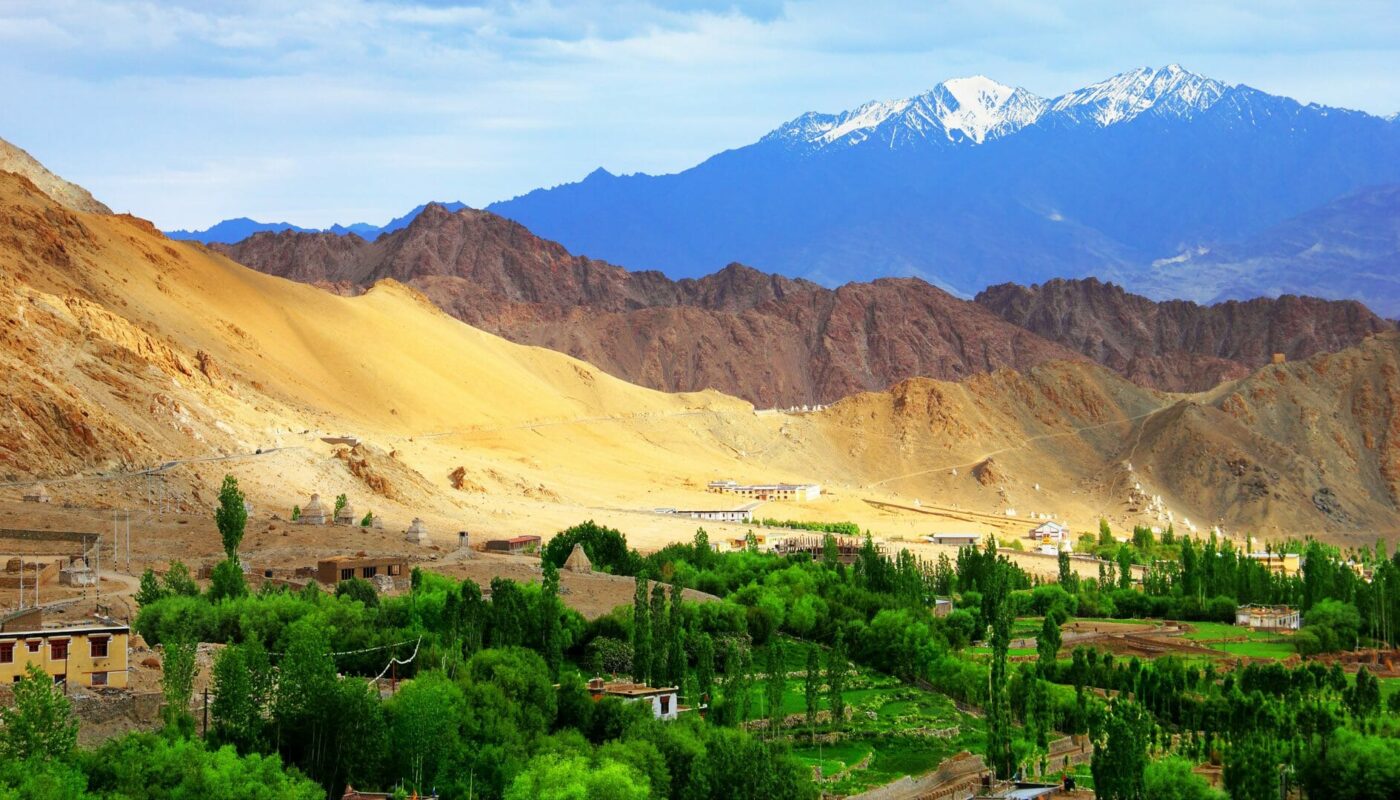Ladakh
Ladakh is most famous for breathtaking landscapes, the crystal clear skies, the highest mountain passes, thrilling adventure activities, Buddhist Monasteries and festivals. Ladakh has graduated from being called a ‘barren cold desert’ to a favourite tourist spot, especially since the release of the movie ‘Three Idiots’. The place is now frequented by tourists and in the peak season, it is hard to escape the crowds. So, if you want to explore the less frequented places to visit in Ladakh, this guide will help you to experience the best of ‘The Last Shangri-La’. Ladakh is the epitome of heaven on earth & one of the best places to visit in Kashmir. Surrounded by ice capped mountains of the Himalayan ranges and Karakoram, with endless stretches of natural beauty at its most pristine stage, it is the perfect getaway if you want to experience a new culture and environment while being away from the hustle and bustle of city life. Due to the rough terrain and high altitude, Ladakh still remains quite unexplored and thus it is full of surprises that will forever be etched in your memories long after you return. Moreover, the interesting yet beautiful culmination of both the Tibetan and Indian cultures in Ladakh will surely give you a very unique travel experience that you can’t find anywhere else.
A huge part of experiencing the real beauty of Ladakh is to endure the harsh climate and rough terrain. It makes the trip more adventurous. Therefore it is important to know which times are perfect for visiting Ladakh so that you can plan your trip accordingly and enjoy the most of what this beautiful paradise has to offer. There are many who suggest summer to be the best time to enjoy Ladakh since the weather becomes more bearable and the scenic beauty becomes more vibrant and joyful. Whereas winters are also great attractions for some travellers as the snow laden surroundings adds to the mysterious charm of the place and make it look like a fairyland. Not many people dare to venture to Ladakh during winter season but it is also the time when the most thrilling treks like Chadar- Trek begins. It is a completely surreal experience to walk over the Zanskar river when it is frozen. However, it is best to avoid the period of mid-May to mid-September as during these months the monsoon season takes full control which results in frequent roadblocks and landslides and that can be quite dangerous. However, the rest of the year is absolutely perfect to enjoy the different vibes and aura of Ladakh. Filled with different attractions, let us explore the best things to do in Ladakh that you should not miss out on.
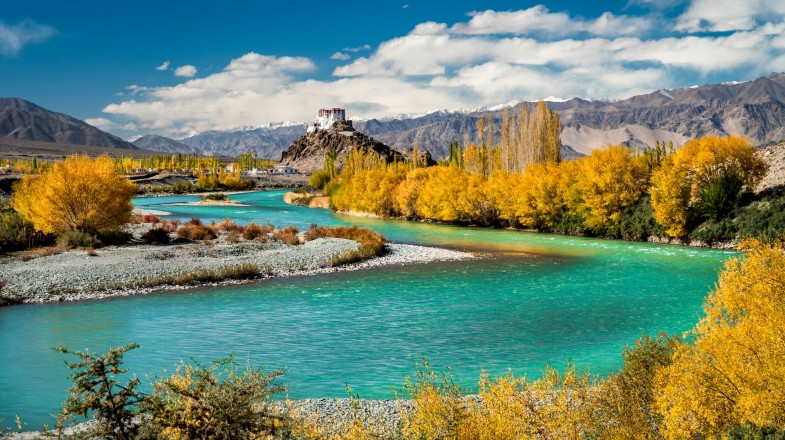
Experience Nature’s True Beauty
From amazing food to exciting and thrilling activities, Ladakh has multiple brilliant things to do and enjoy. It takes you on a journey through the best of natural beauty that will leave you spellbound. You can reach Ladakh either through train and cars or if you are feeling courageous and adventurous then you can even plan a bike or cycling trip along with your friends. The rough mountainous terrain will provide an unforgettable experience that you will not find anywhere else. Be it the serene summers or the chilly winters, Ladakh’s splendour will truly make you fall in love with place. The magnificent mountain ranges coupled with the beautiful rivers and lakes create the most spectacular and picturesque views that cannot be simply described by words. These 10 things you should never miss out on a trip to Ladakh if you wanna feel the pulse of the place.
The beautiful barren land of Ladakh is not very easily accessible throughout the year. In fact. highways leading to Leh are open only between May and October and covered in snow for the remaining months. However, it is still visited by a large number of travelers every year.
How to Reach Ladakh:
BY AIR
The nearest airport is at Leh, which is well connected to Delhi, Jammu, Srinagar, Chandigarh and several other cities in India. From the Leh airport, you can hire a cab to visit your places of interest. Leh city has several accommodation options.
The quickest and simplest way to reach Ladakh is by air. It is also the only means of transport with year-round access to the place — exceptional circumstances, not withstanding. The only airport is located in the town of Leh, called the Kushok Bakula Rimpochee Airport. Many domestic airlines offer regular flights to Leh, from Jammu, Srinagar, Delhi, Chandigarh, Mumbai, Kolkata and from other urban hubs across the country. These include Go Air, Indigo, Vistara, Spice Jet and Air India. While shorter routes such as Jammu or Delhi have direct flights, longer routes could sometimes have a single stop along the way, usually at Delhi. The Leh airport is also a military base, so expect a higher level of security and carry printed copies of your documentation and paperwork for a hassle-free experience.
While flying can get expensive, especially during peak season, it’s still worth it for the reduced time of the journey and the higher level of comfort it affords. Once you land, a taxi and local bus service can be found right beyond the terminal. For about INR 400, you can hire a cab to take the 3.8 km ride to the city centre or yourhotel.
BY TRAIN
The nearest railway station is Jammu Tawi (700 km from Ladakh) which is well connected with Delhi, Kolkata and Mumbai. You can hire a cab or board a JKSRTC bus to reach Ladakh from there.
You wouldn’t usually opt for train travel to Ladakh since the nearest station is located 700 km away in the town called Tawi. Stations like Chandigarh and Pathankot are the other closest options, but they are even further away. Even if you do choose to take a train from your departure city to any of these stations, you’ll have to hire a taxi, jeep or private vehicle to complete the rest of the journey — which could take up to three days. It doesn’t sound ideal but can be a perfect adventurous start to your holiday.
BY ROAD
Ladakh is located 434 km from Srinagar and 494 km from Manali. You can hire a cab or a jeep or board a JKSRTC bus to reach Ladakh. Alternatively, you can embark on a bike trip to Leh from Srinagar, Manali or Chandigarh depending upon the time you have. The highways are shut due to heavy snowfalls during the winter months. So, you can only travel to Ladakh by road between May to September.
Road travel is a popular means of getting to Ladakh, with spectacular views and adrenaline-rush moments promised along the way. The only catch is that the routes are only accessible during the months of May to October, while winter sees Ladakh cut off from most places outside.
You can opt for buses, cars or jeeps or even motorbikes, for a road trip to Ladakh.
Bikes have become a favourite amongst those visiting the region, as it is said to be one of the more exhilarating journeys one can ever take. There are two possible routes — one from Srinagar and the other from Manali. The former is a distance of around 430 km, passing through some of the most majestic Himalayan vistas and scenic towns like Sonmarg, Drass, Kargil, Lamaruyu and the Zoji La Pass. The route from Manali is 490 km, passing through the Rohtang Pass, Keylong, Bharatpur, Upshi and Karu.
While riding to Ladakh sounds incredibly fun, it should only be undertaken if you’re a regular rider, using a sturdy bike such as the Royal Enfield. To get to Manali and Srinagar, you will have to make other travel arrangements such as bus or car.
The other options you could choose include cars, jeeps and buses which cover the same routes and distances. However, the bus rides can be tiring and bumpy. They are mostly offered by JKSRTC and HRTC, with tickets costing about INR 1800-2400. With jeep and car rides you can begin your journey from as far out as Delhi or Chandigarh, eventually bringing you to the gorgeous high passes en route Ladakh. Depending on the vehicle, the cost to rent a car with driver can be upwards of INR 20,000. But it’s worth it for big groups or those looking to travel at their own pace.
Traveling within Ladakh
A road trip to Ladakh and within its beautiful lands is worth every bit of the effort and one of the finest adventures you will ever indulge in. Highly recommended!
18 Places to Explore in Ladakh
- Turtuk
- Uleytokpo
- Basgo
- Sumur
- Panamik
- Rangdum
- Changthang
- Rumtse
- Upshi
- Zanskar Valley
- Pangong Lake
- Diskit Monastery
- Royal Leh Palace
- Nubra Valley
- Drass Valley
- Indus and Zanskar River Sangam
- Tsomoriri Lake
- Khardung La
1. Turtuk, the Land of the Sweetest Apricots
Many of you might have heard of Malana, a village in Himachal Pradesh near the party town of Kasol. The stories of how people there look entirely different from Indians have been drawing tourists, and mind you, the legends are all true. Same kind of thing you will see in Turtuk, one of the last villages before the Line of Control. The people here are pink and white, and look as if they are from Iran or some such place. The reason for this is that these are of Balti descent, and the reason they are here is that Turtuk lies in the Balti region, most of which is in Pakistan and is called Baltistan. Apart from the Iranian-looking people, Turtuk is also known for apricots, supposed to be some of the best on earth. Ask the kids here to pose for photos, and they will do it gleefully
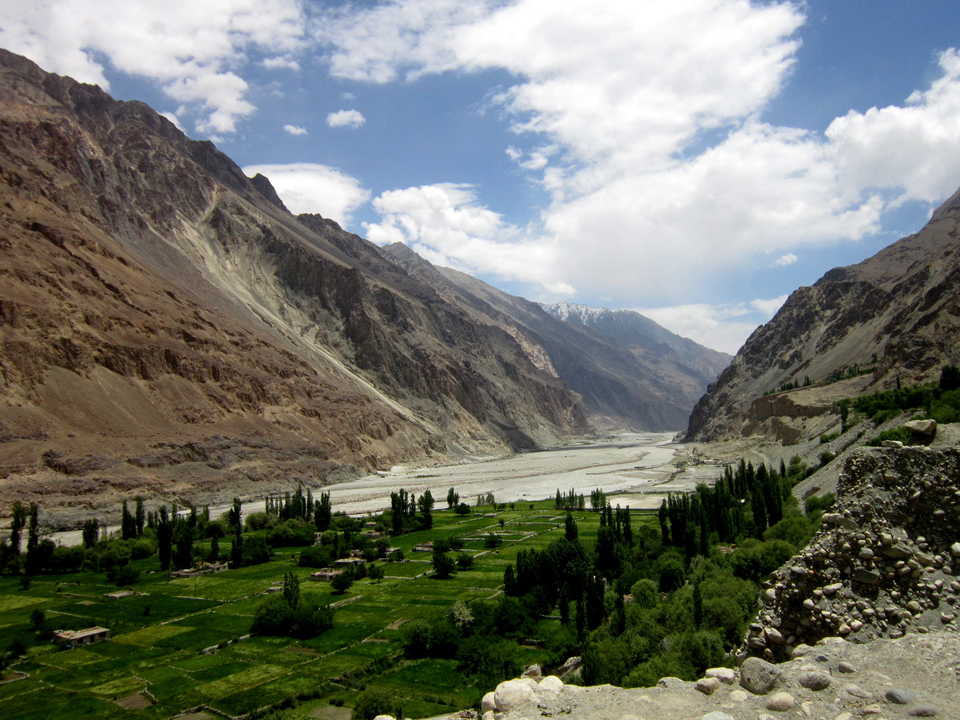
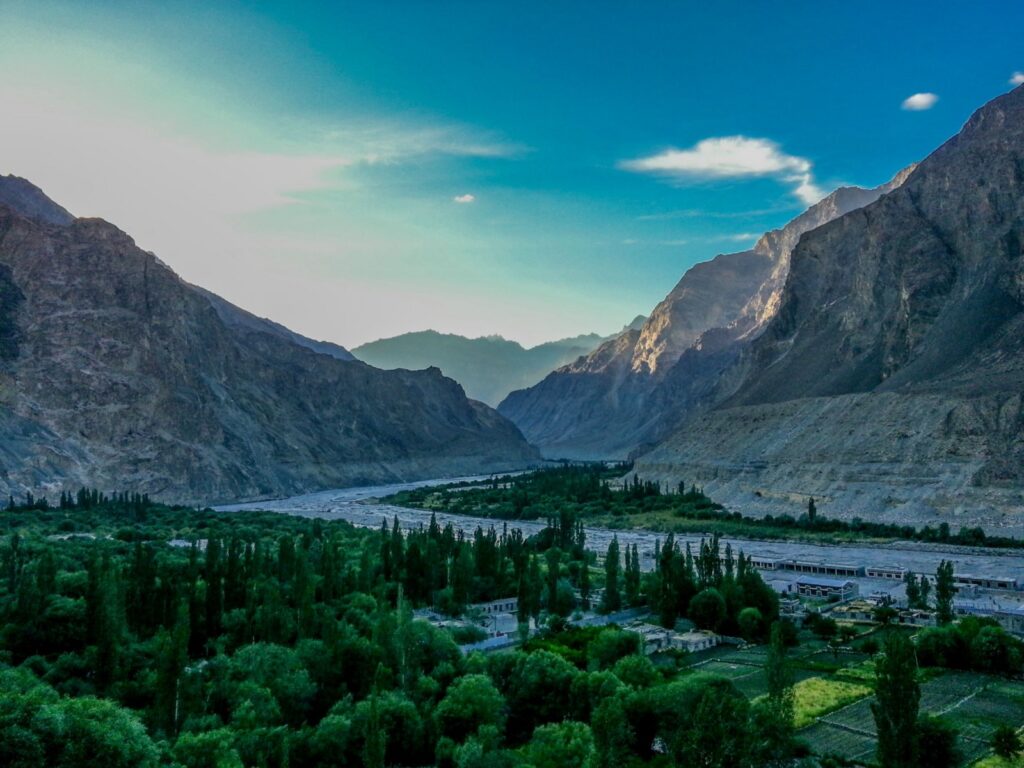
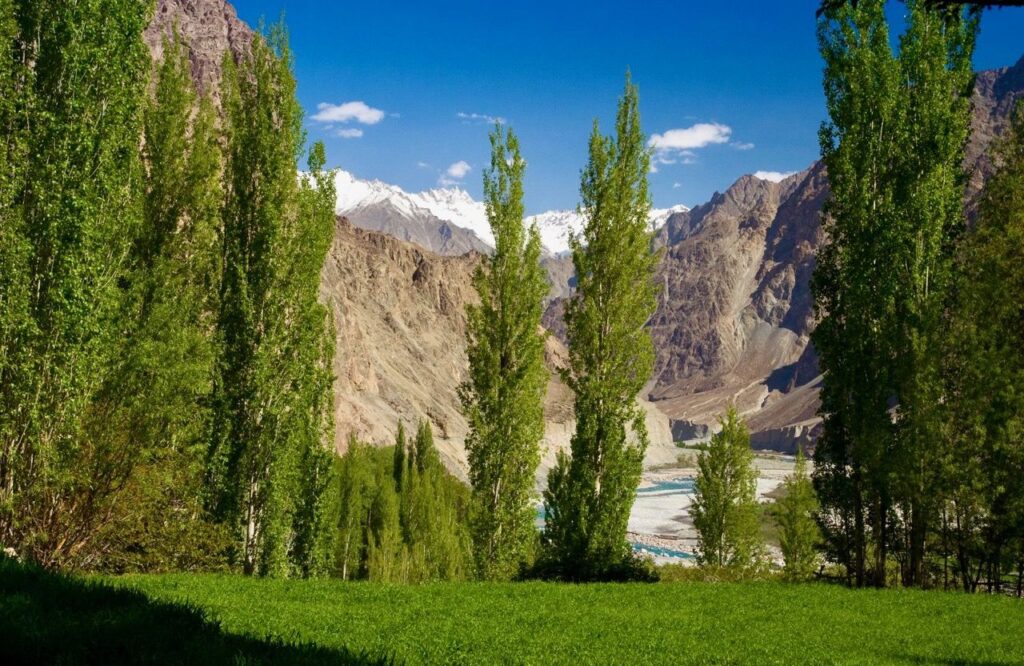
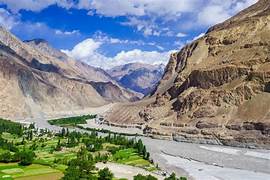
Commonly referred to as a ‘village divided by a border’, Turtuk is located in the Shyok valley, approximately 220 km from Leh. It is one of the best places in Leh-Ladakh and is, without a doubt, the place to visit if you want to be away from the crowd. Surrounded by the Karakoram Mountains, a trek to the Turtuk village from the neighbouring villages like Hundar will add to a great experience.
Turtuk is the northernmost village in the country which is dominated by Balti culture. The majority of the population here practice Islam and are incredibly generous towards visitors. Apricots and walnuts are harvested here in plenty. Located on the banks of Shyok River, this quaint village is cloaked in greenery, which is rarely visible anywhere else in Ladakh. Places of interests here include a waterfall, a monastery, a solitary bridge and a 300-year-old mosque known as Jama Masjid.
Swinging to the lullaby of Ladakh in the northernmost part of India, this farming village has lived it’s days away from the crowd of travelers. But it doesn’t mean that Turtuk loves curious minds any less. Popularly known as village divided by border, this attraction lies close to the Siachen Glacier, the largest in the Indian Subcontinent.
Turtuk has been a part of Pakistan till late 1971, after which it joined the puzzle of India. The land of Baltis (people of Turtuk) was open to tourists from 2010. From the sweet-smelling apricots, smiling faces, wheat farms, every experience at this offbeat place in Ladakh just elates the heart. Besides, you can take a trek down to a waterfall or make your way to the royal palace.
2. Uleytokpo, a Beautiful Camping Ground
Uleytokpo is one of the beautiful camping bases in Ladakh on the banks on the Indus River. Known for its quietness, Uleytokpo is visited by people who want to stay from the city cacophony. The only sounds that break the silence here is the constant murmur of the river and the occasional chirping of birds.
Accommodation here is readily available both in cottages and tents. For sightseeing visit the nearby village called Lamayuru, which is well-known for its lunar-like landscapes. The Yundrung Monastery of Lamayuru is also an interesting place to visit. It is an 11th-century monastery and is famous for its outstanding wood carvings and wall paintings. Other places of interests in the area include Rizong Monastery, Chulichan Nunnery, Likir Monastery and the murals of the Alchi monastery, which are believed to be from 1000 AD.
Peace streams down on the land of Uleytokpo, a small village some 60km away from Leh. This lesser known attraction lies on the way to Lamayuru and is the la la land for adventure lovers. This is because Uleytokpo is a camping base which dips in the charm of Indus River.
Further, this charming village is surrounded by spectacular sights of the Lamayuru Monastery, Rizdong Monastery, Alchi Monastery, Likir Monastery, and Mangyu Temple. But travelers have to go that extra mile to reach all these places and can end the day by river rafting in the Indus Valley.
If you plan a trip to Ladakh in the month of July or August, then you are in for the famous Yuru Kabgyat Festival. This 2-day celebration is devoted to Yama (Lord of Death) and Padmasambhava (Lord of Wealth). The main highlight of the festival is the masked dances performed by monks, also known as Cham dance.
About 60 km from the city of Leh, Uleytokpo is a camping ground on the banks of the Indus River. If you do not want to stay in the city and want some quiet place, this is the perfect place for you. The only constant sound here would be that of the river, and if you are lucky, of regional birds as well. Accommodation is readily available here either in tents or proper cottages. Imagine waking up to the sight of imposing brown cliffs, lit naturally. Feel like having a picnic? You won’t have to go anywhere as the grass in Uleytokpo in summers is lush enough for you to sit on it and relish a leisurely lunch or tea. You have numerous sightseeing options in the area as well.
3. Basgo, a Land of Ancient Ruins
Located roughly 36 km from Leh, the village of Basgo was once an economically wealthy town that had served as the capital of the kings of Ladakh. Today, the only attraction of this place is a monastery and the ruins of a 15th century surreal palace, nestled on a steep hill. The site may look unapproachable, but you can easily reach the spot. The monastery here has three temples – Serzang Temple, Cham Chung Temple and Chamba Maitreya. Inside the monastery, there are wall paintings and copper statues- all portraying incidents from the life of Lord Buddha. Both the palace and the monastery offer sweeping views of the deserted village. There is a mysterious charm that fills the surrounding.
If given a chance to go back in time, history buffs would rush to Basgo. Once a wealthy village, holding great cultural and political importance, all that’s left now are just the ruins. But don’t be disheartened as Basgo in Ladakh district still has the ravages of a 15th-century royal palace and a monastery. The Basgo Monastery has three temples namely Cham Chung Temple, Serzang Temple, and Chamba Maitreya devoted to Maitreya Buddha. Interestingly, the monastery has copper statues and wall painting that depict the life of Lord Buddha.
The village of Basgo is about 36 km from Leh. In its heyday, it was an economically prosperous town and also served as the local capital. Now, there is nothing left of it except for a monastery and erstwhile royal palace, both of which are mostly in ruins. The structures are located on such sharp and high mountains that looking at them would make you think, “Who would live in such an inaccessible place?” But, the truth is that these are not really inaccessible and you can easily reach both of these sites. The monastery consists of three main temples, all dedicated to Maitreya, the Buddha of the future. Like all Buddhist monasteries in Ladakh, it is studded with copper statues and wall paintings, depicting incidents from the life of Lord Buddha. From a distance, the palace may be impossible to spot because of the similarity of its colour to that of the mountains. Both the palace and the monastery offer amazing views of the ghost town below and the bewitching scenery all around (something to click photos of).
Moreover, the deserted village is overshadowed by the different hues of the mountains. The warm hospitality of locals here would make you stay a little longer.
4. Sumur, a Place to Go Mountaineering
A remote village located on the banks of the Nubra River, Sumur offers several trails to smaller hamlets at higher altitudes and is a perfect spot if you are looking for a mountaineering expedition. Other than adventure treks, there is a 19th-century monastery, Samstanling Gompa, built in 1841 by Lama Tsultims Nima. The monastery looks brand new. Inside, there are elaborate paintings on the walls, depicting the various teachings of the Dharmachakra by Lord Buddha. The picturesque village is located 120 km from Leh and is closer to Panamik.
Next on the list of hidden gems of Ladakh comes the name of Sumur. It is a village which is cradled at an altitude of 10,827 ft., on the banks of River Nubra. It is known among the locals for the nearby Samstanling Gompa. This monastery has been a part of the Nubra Valley since 1841 and houses a beautiful painting of deities. Travelers have to hike for 45 minutes from the village to reach the holy shrine.
Along with that, Sumur is open to hikers who love discovering something new every other second. The trails here lead to other villages which are settled on higher altitudes.
Sumur is a small village on the banks of the Nubra River. The most notable place here is Samstanling Gompa, a fairly new monastery, built in 1841. Okay, it might not really be new, but it is when compared to other monasteries in Ladakh that date from the 16th or 17th centuries. I don’t know if it has been well maintained or just well built, but it looks almost as good as new. Inside, you will be amazed at the sight of bright and colourful wall paintings of various deities. You will see large scroll paintings on silk cloth as well, depicting some sort of religious symbol. Coming to the hiking part, there are numerous trails leading to even smaller villages at even higher altitudes. So, if you fancy rigorous mountaineering, then you can definitely follow a trail from here.
5. Panamik, a Perfect Place to Take a Bath in the Hot Springs
This is a small hamlet in the Nubra Valley, about 55 km away from Diskit. The village is home to the hot sulphur springs, which helps to fight the paralysing cold weather of Siachen Glacier, located just a few kilometres away. The hot spring waters here are believed to have therapeutic properties and can cure many diseases. Separate pools have been maintained for men and women both at the shower cubicles and the bath complex. Take a dip in the springs to get rid of stress and feel rejuvenated.
Besides the places mentioned above, you can, go for a 9-day hike to Tso Moriri Lake (located at 4,500 m) from Rumtse, a tiny village on the Leh-Manali highway. Take our word for it, it is absolutely worth it. However, by road, the lake is at a distance of 165 km from Rumtse. The lush greenery along the river banks offers a stark contrast to the barrenness Ladakh is so popular for. Rumtse is a part of the Changthang valley which is characterised by high dry plains, beautiful blue lakes, snow-capped hills and the beautiful Tsomoriri Lake. You must also visit the quaint village of Upshi while you travelling along the Leh-Manali highway. It is located roughly 47 km to the southeast of Leh along the Tanglang La.
Panamik is the next village in this blog that will love visiting on a Ladakh tour. This attraction is settled in Nubra Valley, some 55 km away from Diskit and also close to Ensa Monastery. It is known for hot sulfur springs. Travelers aren’t allowed to go any further than this village as it sits close to the Siachen glacier, the world’s highest battlefield.
Another of those small villages in the Nubra Valley, Panamik is roughly 55 km from the town of Diskit. This village is unique in a way because it is home to a hot sulphur spring, which drastically contrasts the mind-numbingly cold Siachen Glacier, which lies a few kilometres ahead. Panamik is the last village you can visit in the Nubra Valley as civilians are not allowed on the glacier for obvious reasons. So, you may have plenty of time to spend in the village, and I suggest you utilise this opportunity to bathe in the hot springs. As per beliefs, they have medicinal properties, capable of curing various diseases. There are separate pools for women and men in the bath complex as well as shower cubicles. A dip in the therapeutic springs can be a good way to relieve you of stress or any altitude sickness symptoms.
The hot sulfur springs (10,442 ft) are considered to have medicinal properties which can heal diseases. Travelers have to take a permit to visit this village in the Nubra valley.
Even on the darkest days, the sky doesn’t let the light dim down in Ladakh. Which is one reason heaven envy the ‘land of high passes’. A drive out of your city can open ways to top attractions and offbeat places to visit in Leh Ladakh. These places aren’t typical, not a lot of travelers know about it, so you can think we have something exclusive to share. Which in a way makes you special!
6. Rangdum, find your purpose amid the rejuvenating setting
Somewhere on the stretch of Kargil and Padum, the Buddhist village of Rangdum will catch your eye. It is said to be the last hamlet in the isolated area of Suru valley and is visited for the monastery by the same name. Rangdum has two sides to it, one which has colorful hills and the other is dotted with glaciers and mountains.
Talking about the Rangdum Monastery, it is a 16th-century gompa which is home to around 40-45 monks. The overall vibe is peaceful and soothing, the walls are adorned with beautiful frescoes and have statues as well.
If you are planning to spend some time here on your vacation in Ladakh or going to Padum, you can find refuge in the handful of homestays.
7. Changthang, a valley which cherishes the bliss of Tibet and Ladakh
Counted among India’s five ‘bio-diverse regions’, Changthang is a part of Ladakh not explored by many. Cuddled at an elevation of 14,846 ft, this high altitude valley which finds its place in the heart of Tibet and Ladakh.
The valley stretches from eastern Ladakh to Tibet. The area is dominated by Changpa, the nomadic pastoralists, and the Changthang Wildlife Sanctuary. Snow leopards, bharals, gazelles, wolves, and regional birds are found here.
Whether you are on a road trip in Ladakh or just sightseeing in general, you will need a break. You can suffer from altitude sickness here and just tire sooner than usual. Hence, you will feel the need to relax, which you should never overlook. One of the best spots to relax in Ladakh are the hot springs in Chumathang. These are natural pools on the banks of the Indus River, from where hot sulphur-laden water springs forth. You can even see the water slowly slithering its way into the fast-flowing river. You can just sit in one of the pools and say goodbye to your troubles. If you have been trekking in the region, then these springs will be especially relaxing.
Ladakh has often been compared to Tibet because of the similarity in their cultures that are predominantly influenced by Buddhism. There is another reason why this comparison makes sense. A place in Ladakh, called the Chanthang Plateau, is actually a part of Tibet itself. This region is characterised by the absence of trees that are still easily visible in other parts of Ladakh. Located at an altitude of around 15400 feet, Changthang is generally colder than the rest of the Ladakh region, so take lots of warm clothes even in summers. Here, you will get to see lots of Changpa nomads, who rear the endemic Changi goats for their wool. For a bit of nature appreciation, you can head to Changthang Wildlife Sanctuary and see wolves, snow leopards, bharals, gazelles and loads of regional birds. One of the most famous places in Ladakh, Pangong Tso, along with Tso Moriri Wetland Reserve also lies on the Changthang Plateau.
8. Rumtse is every nature lover and trekker’s dream come true
Rumtse is a tiny settlement which opens doors for trekkers to the shimmering Tso Moriri Lake. The village is the loving child of the Rupshu valley and is blessed with natural beauty in abundance. The valley itself is bejeweled with mountains, pastureland, and arid plains. An unknown fact about Rumtse is that it is the first human settlement on the route from Lahaul to Ladakh.
Further, the journey to the lake of Tso Moriri begins from Rumtse and is a 9-day hike. The lush greenery and river banks keep you enchanted and makes one feel differently about Ladakh. You can take a look on our Best tour Packages for Leh Ladakh which will make your vacation planning much easier.
A tiny settlement on the Leh-Manali Highway, Rumtse is the gateway to the scenic lake of Tso Moriri. By road, the lake is about 165 km from the village, but you should be better off trekking. A hike of 9 days will take you to your destination and will be totally worth the effort. All along the way, you will see lush grass along river banks and also on mountains. This will make you realise that Ladakh is not really barren as opposed to the common belief, but steppe vegetation does exist here. On the banks of the lake, you will see probably the lushest grass in the entire Ladakhi region. If you are lucky, you may also get to see numerous regional birds and animals, so keep your cameras ready.
9. Upshi is the loving home of Pashmina goats (Pasmina goat’s fur = Pashmina Shawl)
Last on the list of unexplored places in Ladakh is Upshi. This village is on the Leh-Manali Highway and plays along the Indus River Valley and Tanglang La. The bonniness of this hamlet is hard to miss if you are in Ladakh. The Changthangi goats or Pashmina goats are pampered by the locals as from their fur the famous Pashmina shawls are made.
When it comes Leh Ladakh tours, it is obvious you will fall prey to the famous attractions. But we can always save some journeys for exploring just the extraordinaire. Which is why we thought of jotting down 9 unusual places in Leh Ladakh, which are just known to the keen hearts. Hope you liked the blog and if you have any thoughts on the same, do comment below. It was happy traveling with you, keep following us for more such interesting sojourns.
The village of Upshi is located on Leh-Manali Highway and is reached after descending from Taglang La. If you feel tired of the long road journey or altitude sickness, then you can by all means stop here for the night. Upshi has numerous budget hotels, guest houses and campsites for you to spend the night. Changthangi goats with thick, long hair are a common sight in the area. The locals literally pamper these animals by brushing their fur almost every day, keeping them nice and shiny. It is from their wool that the highly demanded and expensive Pashmina shawls are made. If you have time, then you must visit the numerous monasteries nearby. The monasteries or gompas of Stok, Hemis, Thiksey and Shey are all within 55 km from the village.
10 Zanskar Valley – Ladakh’s Adventure Hub
It would not be wrong to say that the Zanskar Valley is the best place for adventure lovers in Ladakh. If you love getting splashed with water as well as speed, then you ought to go rafting on the Zanskar River. The rafting stretch from Remala to the confluence of the river with the Indus near Nimmoo is over 155 km long. You would go on high rapids and white waters, experience swift descents, get soaked with cold water and pass through gorges. The valley looks like a different world between the barren and snowy mountains, it is so colourful and verdant in summers that you will forget for some time that you are indeed in Ladakh.
The Zanskar River freezes in December and January, and gives you the ultimate chance to trek on the frozen river which is widely known as the Chadar Trek. It is counted in one of the most challenging treks in India.
For ages, porters have walked on the frozen river from Lingshet to Leh, hauling logs. Now, it has become famous as a trek and could be your way to loads of thrill. It will involve walking on a thick sheet of ice and even spending a night in a cave! On the way will be numerous waterfalls, with the water frozen in eerie and amazing shapes. This over 70-km hike will end up being one of the most daring and memorable things you ever do. So, if you are a daredevil, give it a try.
11. Pangong Lake
Pangong Lake is the highest salt water lake in the entire world, located at a height of 4350 metres above sea level. The journey to the lake from Leh takes about five hours and is an experience of a lifetime. The crystal clear waters are a popular breeding ground for several birds and make for a gorgeous experience.
12. Diskit Monastery
One of the most popular monasteries in Ladakh, the Diskit Monastery is located at a height of 10,315 ft. above sea level. It is famous for the enormous Maitreya Buddha statue.
13. Royal Leh Palace
From the top of this nine storey palace, you can experience the marvellous view of the entire Ladakh. You can enjoy the rich cultural heritage of Ladakh in the museum within the palace and also view the Indus Valley and Zaskar range that surrounds the palace. There are several ancient artifacts and paintings preserved for visitors to enjoy.
14. Nubra Valley
The Nubra Valley is a cold dry region where the centre of attraction is the Nubra river. During the months of April to August the valley gets filled with apricot trees which is a sight to behold.
15. Drass Valley
If you want to experience Ladakh’s bitter cold, then you should visit the Drass Valley where the temperature drops as low as -40 degrees Celsius. It is the second coldest place on earth which is inhabited and is covered in snow throughout the year.
16. Indus and Zanskar River Sangam
The confluence of the muddy Zanskar waters and the vibrant green waters of Indus is a magnificent view. It is located to the west of Leh.
17. Tsomoriri Lake
This lake is rich in fauna and flora where you can see multiple varieties of bird species as well as the occasional snow leopard and Tibetan wolf.
18. Khardung La
This is the world’s highest motorable pass and thus the view is amazing.
Delicacies
Ladakh is renowned for its Tibetan cuisine like dumplings, pava, thukpa, khambish and more that you should dig into.
Adventure Sports
Intense treks, rock climbings, mountaineering, cycling, river rafting and more – Ladakh has a lot to offer when it comes to adventure activities.
Now, the next time you go to Ladakh, ditch the usual places and give the above-mentioned sites a try. These will give you a new perspective into the region, its culture, natural beauty and people.

